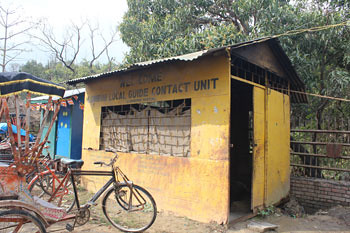Greed and a lack of sustainable long-term vision on the national level have held back Lumbini for too long

TRISHNA RANA
ANYBODY HERE?: A kiosk set up by LDT to help visitors find guides has rusted and lies abandoned at Mahilwar, Lumbini.
Visiting Lumbini is an odd experience. While the historical and spiritual significance of the white box Maya Devi Temple leaves one in awe, if you look underneath its calm veneer, the birthplace of Buddha is contemporary Nepal in a microcosm.
Under the Ministry of Culture, Tourism, and Civil Aviation, the Lumbini Development Trust (LDT) has been implementing the master plan drawn up by Japanese architect Kenzo Tange in 1978 and managing the 1x3 mile zone since 1985. However 35 years on, the larger Lumbini area is still not in the picture and the project is moving at snail’s pace.
The state’s inability to support LDT financially is one reason for three decades of foot dragging. Out of its Rs 130 million budget for 2011, the government could only supply Rs 15 million. While international support for the master plan remains strong, none of that has translated into monetary help.
The high-turnover rate at the Trust as well as the ministry has prevented continuity of ongoing projects as each new incumbent comes with his own agenda. Since 2008 there have been three vice-chairmen at LDT.
The large chunk of the problem, however, lies in the Trust’s inability to move with the times and its refusal to be flexible on the master plan. Ask officials at LDT about why there aren’t even basic services like information officers and centres, guided tours or guides on hire, the usual response is, “We will start once the master plan is completed.”
Architect and UNESCO consultant Kai Weise says LDT’s should remain true to the spirit of the master plan without necessarily following every single detail. But this would require a major shift in the style of functioning not just of the Trust but the entire ministry.
Like other ‘big fish’ projects in Nepal, greed, conflict of interest, and a lack of sustainable long-term vision on the national level have held back this international heritage for far too long. The government’s notorious lack of foresight was on display during the Nepal-India Tourism Mart organised in Lumbini this January.
The Indians came prepared with books, posters, and other promotional material about the Buddhist pilgrimage circuit in their country whereas ours showed up empty handed. The state was similarly ill-prepared to organise Visit Lumbini 2012, right at the heels of Nepal Tourism Year 2011, and the event came and went without much fanfare.
As the birthplace of Buddha, Lumbini should ideally be the starting point of the pilgrimage circuit. Unfortunately, most foreigners journey through Kushinagar, Sarnath, Bodhgaya in India and finally make a few hours ‘lay-over’ here. Out of the nearly 4,000 tourists that arrive each day only 1,200 or so (30 per cent) stay overnight.
When asked why it’s so difficult to get tourists to spend more time and money on our side of the border, officials get defensive and shift the blame elsewhere. “Our responsibility is to develop and protect the world heritage site and surrounding areas, not to do business,” says a LDT officer, “it’s the job of travel agencies and hotels to sell the place, network with their counterparts in India, attract more tourists, and convince them to stay longer.”
As both vie for the largest piece of the Lumbini pie, this turf war between the government and private businesses is not only hurting those who spend thousands to come here but also defeats the spirit of the Buddha.
Instead of working as partners these various parties treat each other as adversaries. The tension between the LDT and hotel owners in particular is palpable. Hotels blame LDT for killing business by allowing monasteries within the Lumbini complex to open hostels and house pilgrims for cheap.
“The number of tourists has soared, but our business has not been able to keep up,” explains the manager of Hotel Peace Land in Lumbini, “LDT’s unfair policies are driving us out.”
The Trust, on the other hand, says hotels in the area haven’t bothered to improve their quality or contributed towards Lumbini’s development in anyway and are only concerned about squeezing every last penny out of visitors.
But all this ping pong politics holds little significance for rickshaw drivers like Krishna, who earns around Rs 600 a day taking tourists around the garden. Families like his are hardly ever included in national and international discussions about Lumbini’s ‘development’. And while the windfall from Buddhaland provides employment to some, it has done little in terms of uplifting living standards or improving education in the region.